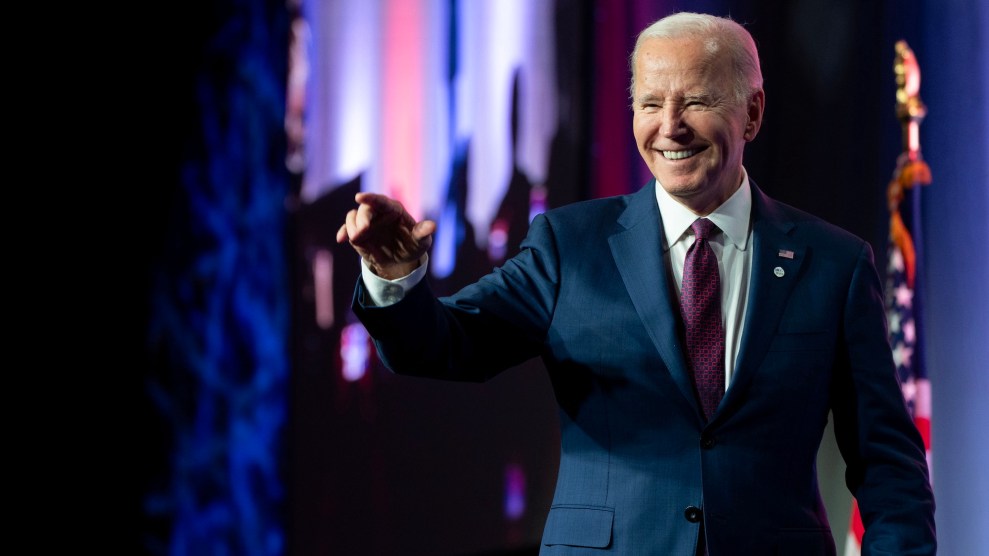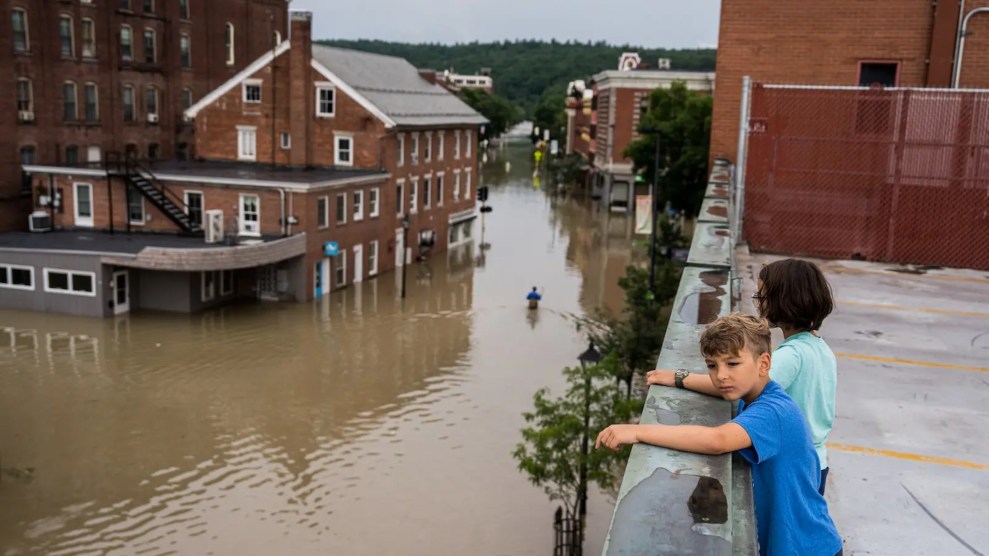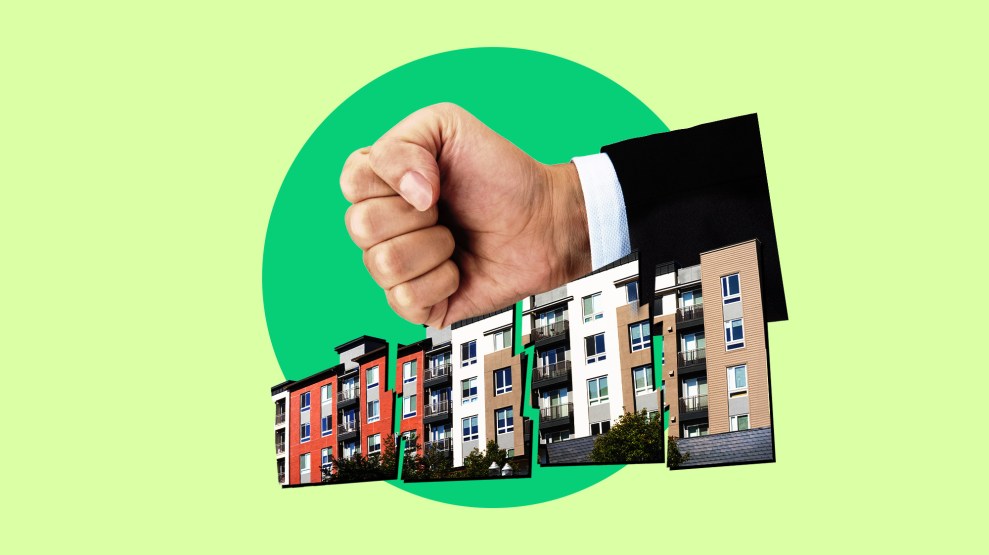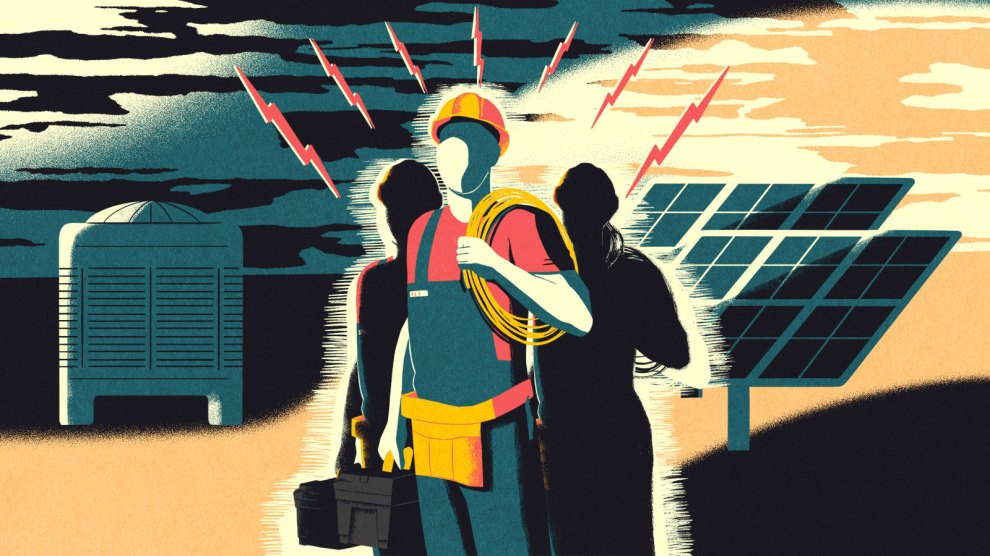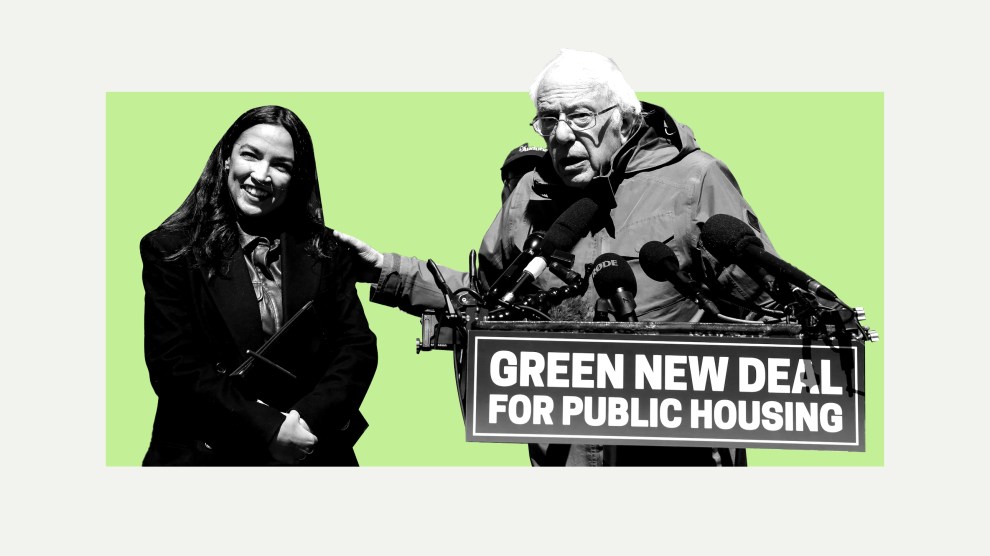
Rep. Alexandria Ocasio-Cortez (D-N.Y.) and Sen. Bernie Sanders (I-Vt.) take part in a press conference with other Democratic lawmakers and advocates reintroducing the Green New Deal for Public Housing.Mother Jones illustration; Francis Chung/POLITICO/AP
This story was originally published by the Guardian and is reproduced here as part of the Climate Desk collaboration.
With a sweeping legislative proposal, Representative Alexandria Ocasio-Cortez and Senator Bernie Sanders are attempting to place public housing at the center of the green energy transition, tackling the twin crises of global warming and soaring housing costs.
“Public housing should be the gold standard for affordable, environmentally friendly, and safe communities,” Ocasio-Cortez said in an email. “This bill is how we ensure that.”
The Green New Deal for Public Housing aims to decarbonize all of the nation’s public housing units—and build more of them—with an investment of between $162 billion and $234 billion over the next decade. In doing so, it would avert 5.7 million tons of greenhouse gas emissions, the equivalent of removing 1.26 million cars from US roads each year, while creating jobs and public health benefits.
The proposal is co-sponsored by a slew of other progressive lawmakers and supported by dozens of environmental groups, housing justice organizations and labor unions.
“We are going to provide decent-quality, affordable housing for millions of Americans, and at the same time, we’re going to create good-paying union jobs,” said Sanders at a Thursday press conference. “That is a win, win, win situation.”
It is not likely to pass, but supporters say it can help build support for the vision.
The bill’s reintroduction comes as the nation faces an unprecedented shortage of affordable housing. In 2022, a record half of US renters spent more than 30 percent of their income on rent, a January report from Harvard University found—and more than half of these “rent-burdened” Americans spent upwards of 50 percent on rent.
Public housing remains an affordable option that 1.7 million Americans rely on. But amid a chronic lack of investment, it is often allowed to fall into disrepair, creating a maintenance backlog of $70 billion.
In the absence of funds to mend these units, they are often demolished or privatized instead. As a result, the US public housing stock shrunk from 1.2m units to just over 900,000 between 2009 and 2022—a 25 percent decline—according to an analysis from the progressive thinktank Climate and Community Project, which informed the policy proposal.
Instead of allowing the nation’s public housing stock to wither away, the bill seeks to transform it. Units would not only be repaired and freed of contaminants like lead and mold, but also made efficient and green.
Each would be insulated and weatherized to conserve energy, as well as outfitted with fossil fuel-free electric appliances. Renewable energy would be installed on-site. And developments would be made climate-resilient with increased green space and decreased paved areas, which can help absorb heat and soak up water during heavy rains.
In addition to slashing greenhouse gas pollution, the bill would come with “major health and comfort benefits,” said Kira McDonald, a researcher at Climate and Community Project who co-authored the report.
Removing fossil fuel-powered appliances would lower air pollution and therefore improve residents’ respiratory health. And insulation and heat pumps could cut energy bills, while making homes easier to keep at a comfortable temperature amid extreme weather.
The Green New Deal for Public Housing would not only improve the nation’s existing public units, but also “finally help build more,” said Ocasio-Cortez. Currently, the 1998 Faircloth Amendment in effect prevents the federal government from funding new public housing, but the proposal would immediately repeal that policy in order to erect more state-of-the-art, green units.
The policy would benefit the US’s most vulnerable residents. Public housing residents are disproportionately likely to be people of color, and 24 percent of public housing residents are living with a disability.
“The Green New Deal for Public Housing is going to change the game for those of us and our neighbors who are being hit hardest by the climate crisis,” said Saul Levin, legislative and political director of the progressive advocacy group Green New Deal Network.
The policy also would have knock-on effects for the entire nation, including by spurring the creation of about 280,000 jobs over a decade. The bill includes language to ensure those jobs are all unionized.
It could also help create a supply of efficient technologies for all residents. Last year, New York City’s public housing authority invited manufacturers to compete for a contract to create and install at least 10,000 induction stoves in New York City Housing Authority (Nycha) buildings, specifically calling for apartment-sized models that do not require electrical upgrades. The winning model will become available on the market for all US residents.
“Those models are available elsewhere, but not in the US because producers basically don’t see that there is a strong enough market,” said McDonald. “This can change that.”
Nycha has launched a similar program to bring small heat pumps on to the US market, and back in the 1990s put out a call for small, energy-efficient refrigerators that helped shape the green fridge market.
“There are gaps in green building technology and green appliance markets in the US,” said McDonald. “Public housing can help fill them … so this policy is also a form of green industrial policy.”
Public housing is the only form of US housing whose affordability does not rely “solely on the market and solely on billionaires,” Ocasio-Cortez said at Thursday’s press conference.
Jasmine Sanchez, a housing advocate who lives in a Nycha development, said many public housing residents face the “constant threat of privatization” and often feel left behind by the US government. “Everyone deserves to be invested in and everyone deserves to live threat free,” she said.
Though the bill is not expected to pass, Climate and Community Project says support to expand and improve public housing is growing. In 2021, the report notes, the House voted to repeal the Faircloth Amendment and most Democratic lawmakers supported including $60 billion for public housing in the spending package that later became the Inflation Reduction Act, though both measures ultimately failed to pass.
“While just a couple of senators ultimately blocked these reforms, it was clear that there is already strong support for saving public housing that advocates can build on,” the report says.
The policy represents a “visionary future that will uplift everyone,” said Levin of Green New Deal Network. “By lifting up the world we need,” he said, “we are building toward that vision.”
Correction: An earlier version of this story misstated a statistic from the Harvard report on “rent-burdened” Americans.
